Market Overview
The Global 8K Technology Market size is projected to reach USD 42.7 billion in 2025 and grow at compound annual growth rate of 55.7% from there until 2034 to reach a value of USD 2,296.2 billion.
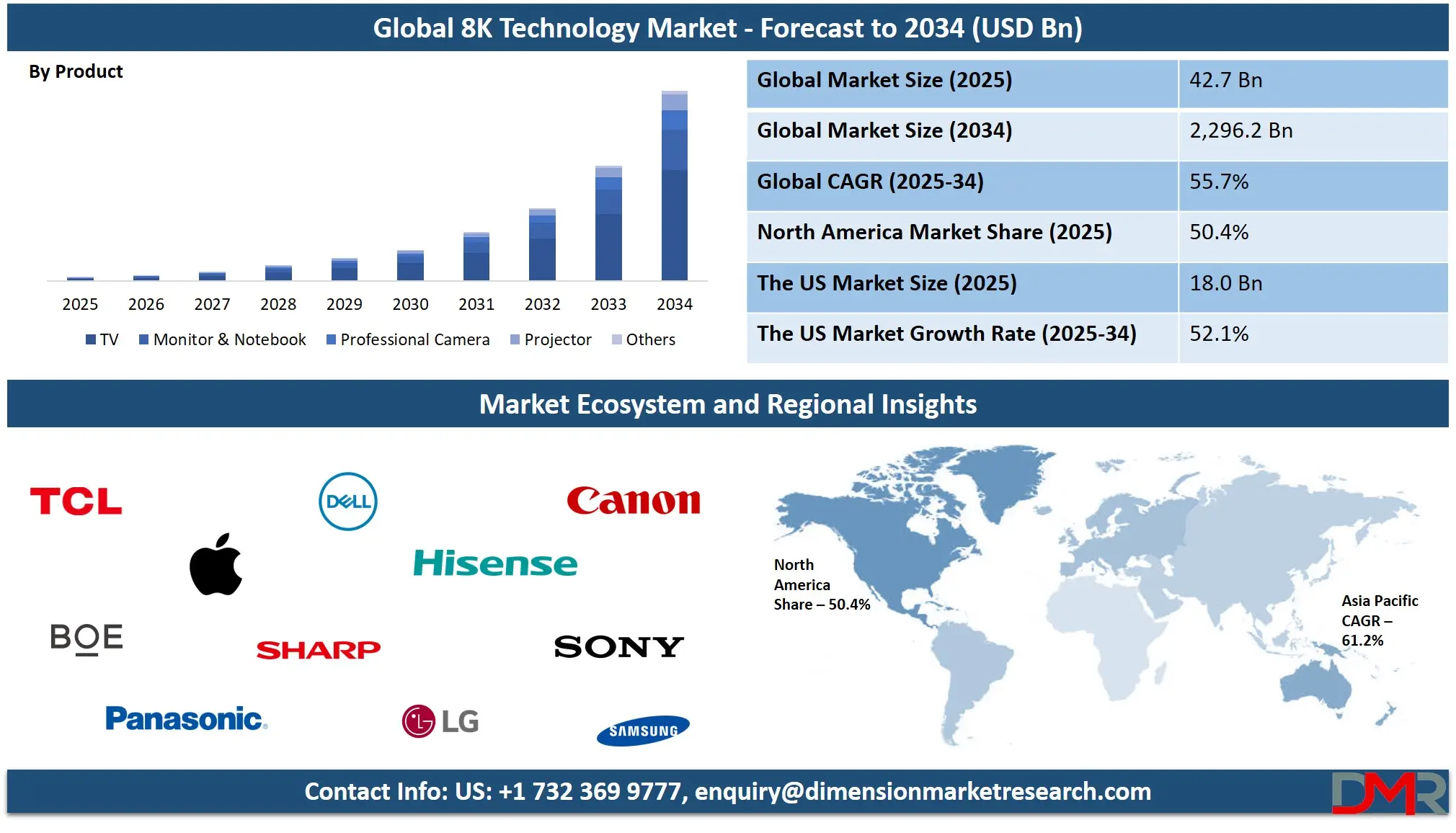
8K technology refers to a screen resolution of 7680 × 4320 pixels, which is four times higher than 4K and sixteen times higher than Full HD. This ultra-high-definition (UHD) format offers extremely sharp and detailed images, making it ideal for large displays and high-end applications such as home theaters, medical imaging, digital signage, and advanced gaming. The term "8K" is based on the horizontal pixel count, which is nearly 8,000 pixels. Devices supporting this resolution include televisions, computer monitors, and professional cameras.
Over the past few years, there has been growing interest in 8K technology, driven by advancements in display manufacturing, increasing content creation, and demand for lifelike visual experiences. Television manufacturers and tech companies have introduced several 8K models, especially in premium categories. While 8K content is still limited, demand is gradually rising due to the increasing production of high-resolution media and improvements in streaming capabilities. Industries like broadcasting, cinema, and healthcare are also showing interest in 8K for its ability to show fine details.
Several notable trends have shaped the 8K technology landscape. First, companies are working on upscaling technology to improve the appearance of non-8K content on 8K screens. Second, AI-powered enhancements are being used to sharpen images and improve video quality. Third, gaming consoles and PC graphics cards are being upgraded to support higher resolutions. Lastly, there is a push for 8K streaming solutions, although bandwidth limitations still present a challenge.
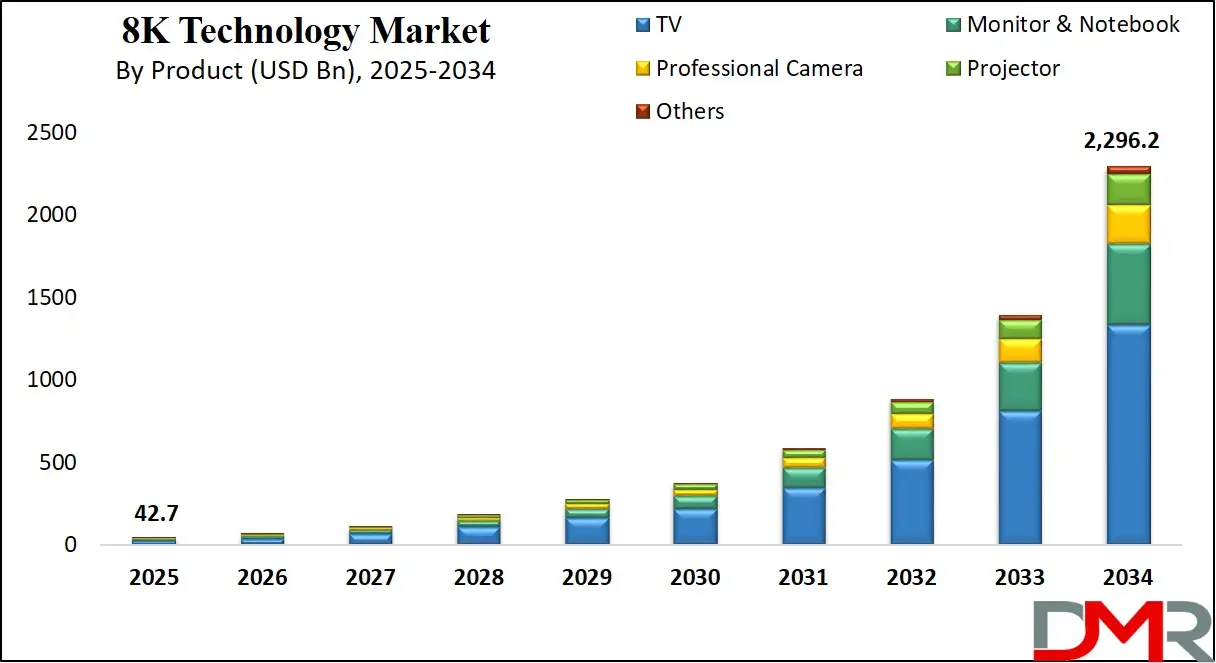
A few significant events have helped bring 8K into the spotlight. Leading tech events like CES have showcased new 8K TVs and innovations. Sports broadcasters have tested 8K feeds during large events such as the Olympics and football championships. Camera makers have also launched professional-grade 8K video recording equipment, making it easier for filmmakers and content creators to adopt the format. International standards bodies have also worked on setting guidelines for 8K transmission and content delivery.
Despite the advancements, 8K technology faces several challenges. One major issue is the lack of native 8K content. Streaming 8K video requires very fast internet and large amounts of data, which can be expensive and inefficient. Displaying 8K also requires powerful processors and graphics systems, limiting its accessibility to high-end users. Moreover, to fully enjoy 8K resolution, viewers need very large screens and must sit close enough, which is not always practical in regular home settings.
The US 8K Technology Market
The US 8K Technology Market size is projected to reach USD 18.0 billion in 2025 at a compound annual growth rate of 52.1% over its forecast period.
The US plays a key role in the development and growth of the 8K technology market. It is home to several major technology companies that drive innovation in display manufacturing, video processing, and content creation tools. The US also leads in producing high-quality media, including films, streaming content, and games, which are increasingly exploring 8K formats.
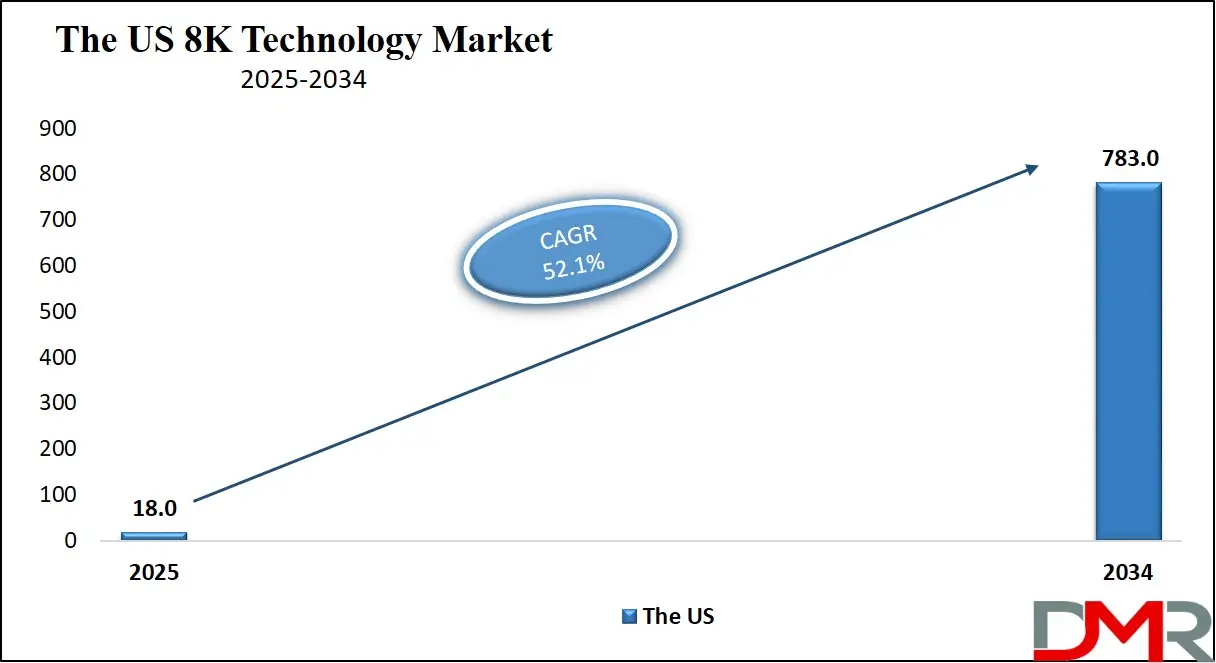
Investment in R&D and strong collaboration between hardware makers and software developers further support advancements. In addition, the US market shows early adoption of high-end electronics, helping push demand for 8K TVs, monitors, and professional equipment. With strong infrastructure, a tech-savvy population, and global media influence, the US significantly shapes the direction and pace of the 8K technology market.
Europe 8K Technology Market
Europe 8K Technology Market size is projected to reach USD 8.9 billion in 2025 at a compound annual growth rate of 53.5% over its forecast period.
Europe plays an important role in the 8K technology market through innovation, regulation, and adoption. Several European countries are known for high-quality engineering and manufacturing of advanced display components and imaging equipment. European broadcasters and media houses are also experimenting with 8K content for sports and cultural events. The region places strong emphasis on energy efficiency and quality standards, which influences how 8K products are designed and marketed.
Europe also collaborates with global players, including those from the US and Asia, in developing next-gen video compression and transmission standards. While consumer adoption is still growing, Europe’s focus on premium electronics, professional applications, and research-driven technology makes it a key contributor to the global progress of the 8K technology market.
Japan 8K Technology Market
Japan 8K Technology Market size is projected to reach USD 2.1 billion in 2025 at a compound annual growth rate of 57.3% over its forecast period.
Japan has played a pioneering role in the development of 8K technology, being one of the earliest countries to invest in its research and implementation. Japanese companies were among the first to showcase 8K televisions, cameras, and broadcasting equipment. Japan also led global broadcasting milestones, including early 8K test transmissions for public events.
The country’s strong focus on precision technology and imaging quality has helped push boundaries in resolution and display clarity. Government-backed initiatives and collaboration with media organizations have supported the 8K ecosystem's growth. Japan’s contributions have influenced global standards and inspired adoption in other regions, including the US and Europe. Its leadership continues to shape the evolution of ultra-high-definition content and display technologies worldwide.
8K Technology Market: Key Takeaways
- Market Growth: The 8K Technology Market size is expected to grow by USD 2,232 billion, at a CAGR of 55.7%, during the forecasted period of 2026 to 2034.
- By Product: The TV s is anticipated to get the majority share of the 8K Technology Market in 2025.
- By End User: The sports & entertainment segment is expected to get the largest revenue share in 2025 in the 8K Technology Market.
- Regional Insight: North America is expected to hold a 50.4% share of revenue in the Global 8K Technology Market in 2025.
- Use Cases: Some of the use cases of 8K Technology include broadcasting & live events, medical imaging & diagnosis, and more.
8K Technology Market: Use Cases
- Broadcasting and Live Events: 8K technology is used in broadcasting large-scale live events like sports, concerts, and ceremonies. It provides extremely clear visuals, allowing viewers to see fine details even from far distances, which enhances the overall viewing experience and brings a sense of realism to the screen.
- Medical Imaging and Diagnosis: In healthcare, 8K displays are helpful in surgery and diagnostics where high precision is needed. The ultra-sharp visuals allow doctors to see tissues, organs, and abnormalities more clearly, as they can support more accurate procedures and better patient outcomes.
- Film Production and Post-Processing: Filmmakers use 8K cameras and monitors to shoot and edit content with maximum detail. This gives more control in post-production for cropping or stabilizing footage without losing quality. It also ensures future-proofing for content as display technologies advance.
- Advertising and Digital Signage: 8K is used in premium advertising displays, especially in large public spaces like malls and airports. It captures attention with vibrant, detailed visuals that stand out even in bright environments. Brands use it to create eye-catching, high-impact marketing content.
Market Dynamic
Driving Factors in the 8K Technology Market
Rising Demand for Ultra-High-Resolution Visual Experiences
One major growth driver for the 8K technology market is the increasing consumer and professional demand for ultra-high-resolution visuals. As people become more familiar with 4K, there's a growing interest in even sharper and more immersive viewing experiences. 8K offers extremely detailed images that are especially noticeable on large screens, making it ideal for home theaters, gaming setups, and digital exhibitions.
This trend is also influenced by the growing use of 8K in museums, art galleries, and virtual reality applications. Professional industries such as medical, design, and media production also require higher resolutions for better accuracy and creative flexibility. As expectations for visual quality increase, 8K is emerging as a key solution for next-generation display standards.
Advancements in Display Technology and Content Creation Tools
Another key growth driver is the continuous progress in display manufacturing and video production technologies. Display panels are becoming more efficient, thinner, and cost-effective, allowing manufacturers to produce 8K screens at more accessible prices. At the same time, improvements in camera sensors, editing software, and AI-driven upscaling tools are making it easier to create and optimize 8K content. Innovations in video compression and faster internet speeds are also helping address the challenges of transmitting large 8K files. Together, these developments are removing the earlier barriers that limited the growth of 8K. As technology becomes more capable and integrated, both consumers and industries are more likely to adopt 8K as a future-ready solution.
Restraints in the 8K Technology Market
High Cost of 8K Devices and Supporting Infrastructure
One of the biggest restraints in the 8K technology market is the high cost associated with 8K displays, cameras, and other equipment. These devices require advanced components, which significantly increase production costs. In addition to the hardware, users need high-performance graphics cards, powerful processors, and large storage capacities to handle 8K content. This makes the overall setup expensive and limits adoption mostly to high-end or professional users. For everyday consumers, the price difference between 4K and 8K often doesn't justify the upgrade, especially when content availability is limited. Until costs come down, affordability will remain a key barrier, slowing down the mass-market adoption of 8K technology.
Limited Native 8K Content and Streaming Challenges
Another major restraint is the lack of native 8K content and the challenges in delivering it. Very few movies, shows, or live broadcasts are produced in 8K, and most current content is still made in 4K or lower resolutions. Even with AI upscaling, the true visual advantage of 8K can only be realized with native high-resolution content. Moreover, streaming 8K video requires extremely fast internet and a large amount of data bandwidth, which is not available in many regions. This creates performance issues such as buffering or quality drops. Without strong content support and reliable delivery systems, users may not see the full benefits of 8K, which can discourage investment in the technology.
Opportunities in the 8K Technology Market
Expansion in Professional and Industrial Applications
A significant opportunity for the 8K technology market lies in its adoption across professional and industrial sectors. Fields such as medical imaging, scientific research, aerospace, architecture, and surveillance benefit from ultra-high-definition visuals for accuracy and detailed analysis. For example, in surgery and diagnostics, 8K enables clearer viewing of fine tissues and structures. In design and simulation, it offers better visualization of complex models. As industries demand greater precision and clarity, 8K solutions are becoming increasingly relevant. The ability to zoom in on detailed sections without image loss also adds value in technical fields. This growing professional demand opens new revenue streams beyond consumer electronics, helping to diversify and strengthen the 8K market.
Growth of 8K Content Creation and Streaming Ecosystems
Another promising opportunity is the development of a complete 8K content and streaming ecosystem. With more filmmakers, studios, and content creators beginning to experiment with 8K production, the availability of native 8K media is slowly rising. Advancements in camera technology, video editing tools, and AI-powered upscaling further support this shift. Simultaneously, streaming platforms and broadcasters are investing in infrastructure to handle ultra-high-definition delivery. As internet speeds improve and 5G becomes more widespread, streaming 8K content will become more practical for global audiences. This growing ecosystem encourages both content creators and consumers to adopt the format, paving the way for wider acceptance and usage of 8K technology in everyday entertainment.
Trends in the 8K Technology Market
AI‑Powered Upscaling and Processing
A major trend is the rise of AI‑driven upscaling technologies that make 4K and HD content look near‑native on 8K displays. Newer systems use smarter models that reduce memory needs and improve efficiency—some updates have significantly cut VRAM usage while still delivering excellent visual output. These tools also adapt processing in real time, optimizing different parts of the image independently. This allows displays to animate smoothly without needing full-scale computing power. As a result, 8K viewing becomes more practical and accessible. Such AI-enhanced features are being integrated into both premium TVs and gaming systems, helping bridge the gap between limited native 8K content and everyday viewing needs.
Next‑Gen Connectivity and Display Evolution
Another key trend is the development of new hardware standards and panel technologies tailored for 8K content. Advanced HDMI standards with higher bandwidth are being adopted to support ultra‑high‑resolution formats, making transmission of 8K video smoother and more reliable. At the same time, display manufacturers are introducing innovations like MicroLED, mini‑LED, and improved glare-reduction coatings in 8K screens. These panels offer better brightness, contrast, and energy efficiency. Industry showcases continue to highlight progress in anti-glare displays, AI-linked processors, and sleeker designs. Altogether, these developments are positioning 8K screens not just as high-end novelties but as practical, high-performance tools for both entertainment and professional environments.
Impact of Artificial Intelligence on 8K Technology Market
Artificial Intelligence (AI) is playing a major role in shaping the growth and application of 8K technology. One of the most important uses of AI in this space is intelligent upscaling. Since native 8K content is still limited, AI helps improve lower-resolution videos—like 4K or Full HD—by filling in missing details and enhancing clarity to match near-8K quality.
AI-powered algorithms analyze image patterns, textures, and colors to produce sharper, more natural visuals in real time. This has made 8K televisions more useful even without a large supply of native content. AI also helps in reducing processing time and improving energy efficiency, making 8K systems smoother and more practical for daily use.
Beyond display enhancement, AI is also contributing to content creation and delivery in the 8K market. Advanced AI tools are used in editing, color correction, and real-time rendering of ultra-high-resolution videos, which helps speed up production workflows in film and broadcasting. AI also supports compression and transmission of large 8K files by optimizing bitrates without reducing quality, making streaming more accessible on limited bandwidth.
In professional applications like medical imaging, AI works with 8K visuals to detect patterns, highlight anomalies, and support accurate diagnosis. As AI continues to evolve, it is expected to make 8K technology more affordable, efficient, and widely used. This strong partnership between AI and 8K not only improves user experience but also helps solve challenges related to performance, content availability, and delivery, driving faster adoption across industries and consumer markets.
Research Scope and Analysis
By Product Analysis
TV segment is expected to be leading in the 8K technology market in 2025 with a share of 58.1%, as growing consumer interest in ultra-high-definition home entertainment continues to push demand for advanced display products. With larger screen sizes becoming more popular and prices gradually dropping, 8K televisions are gaining traction in both developed and emerging markets. Enhanced visual quality, immersive viewing, and integration with smart home systems are making these TVs attractive to tech-savvy users.
Leading brands are focusing on improving contrast, brightness, and color accuracy, further boosting interest. Streaming platforms and gaming devices are also beginning to support 8K resolution, encouraging more households to upgrade. The TV segment remains central to 8K adoption as it combines everyday use with next-generation visual experience, making it one of the most visible and accessible entry points for consumers into the 8K ecosystem.
Professional camera segment is anticipated to witness significant growth over the forecast period in the 8K technology market, driven by rising demand from film production, broadcasting, and commercial media industries. These cameras are crucial for creating native 8K content, which is essential for fully utilizing the capabilities of 8K displays. As video platforms and filmmakers seek to deliver sharper, more detailed visuals, professional-grade 8K cameras are becoming more relevant.
This trend is also supported by improvements in image sensors, optical performance, and post-production tools. The growing use of high-resolution cameras in live sports coverage, documentaries, and virtual reality experiences adds further momentum. Additionally, advancements in storage and editing software make handling large 8K files more manageable, encouraging adoption among content creators. As more industries explore 8K applications, professional cameras are positioned as a key product segment enabling high-quality production and helping accelerate the overall market's growth.
By End User Analysis
Sports & entertainment segment is set to lead the 8K technology market in 2025 with a share of 45.8%, driven by the growing need for ultra-high-definition viewing experiences. Broadcasters and streaming platforms are adopting 8K to offer lifelike clarity during live events, including football matches, concerts, and major global tournaments. Fans are looking for more immersive and realistic visuals, and 8K delivers that with sharper images, deeper colors, and smoother motion.
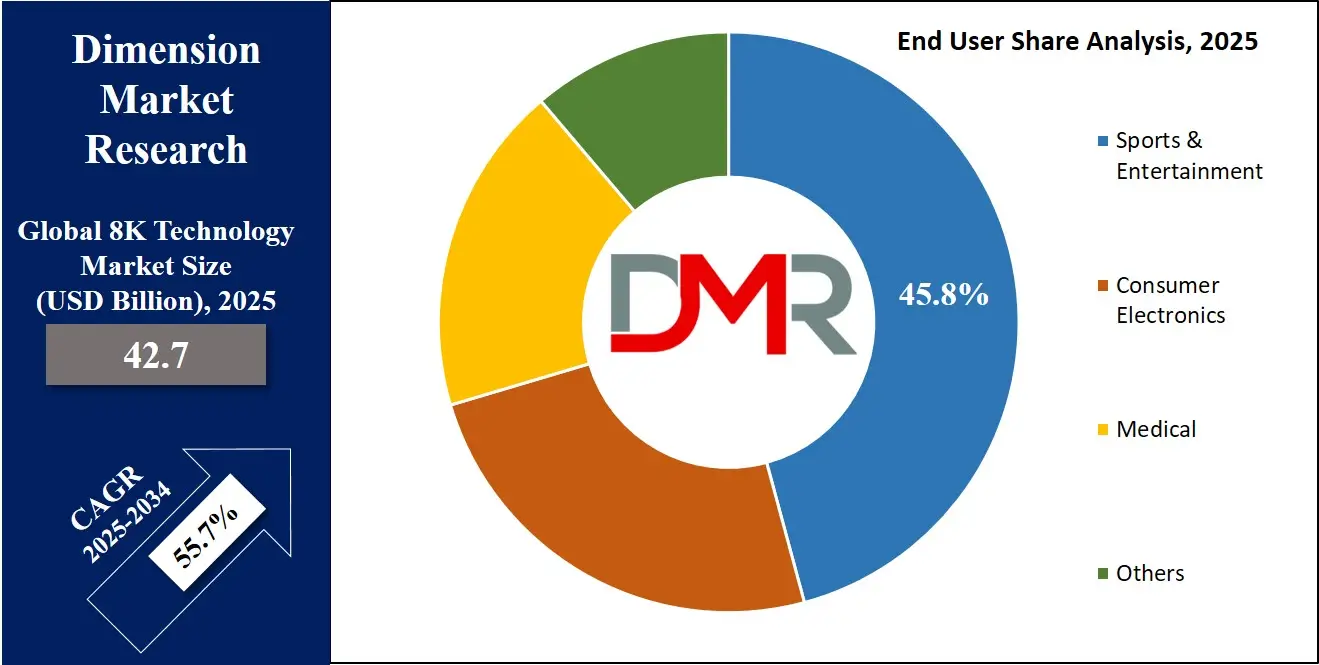
Content creators and production studios are also using 8K cameras to capture footage that allows flexible editing without quality loss. Stadiums and arenas are integrating large 8K screens to enhance the in-person viewing experience. As demand for top-tier visual quality grows, sports and entertainment continue to push the adoption of advanced display technology, making this segment a major contributor to the expansion of the 8K ecosystem worldwide.
Medical segment is projected to experience significant growth over the forecast period in the 8K technology market, supported by its critical need for precision and detail. In surgical procedures, diagnostics, and training, 8K resolution helps deliver highly accurate visuals that aid medical professionals in making better decisions. From endoscopy to robotic surgery, the use of ultra-clear imaging allows for more controlled and confident actions.
Hospitals and research centers are increasingly investing in high-resolution displays and imaging equipment to improve outcomes and reduce errors. With ongoing advancements in imaging technology and growing awareness of its benefits, the medical field is turning to 8K to enhance visualization in complex procedures. This rising adoption highlights the important role of 8K in healthcare, helping to transform how medical professionals diagnose, treat, and educate.
The 8K Technology Market Report is segmented on the basis of the following:
By Product
- TV
- Monitor & Notebook
- Professional Camera
- Projector
- Others
By End User
- Sports & Entertainment
- Medical
- Consumer Electronics
- Others
Regional Analysis
Leading Region in the 8K Technology Market
North America is expected to lead the 8K technology market in 2025 with a share of 50.4%, driven by strong demand for advanced display systems, growing investment in content creation, and widespread use of cutting-edge consumer electronics. The region is home to major technology innovators and media production companies that are actively involved in developing 8K displays, cameras, and editing tools. With a high adoption rate of premium televisions, gaming consoles, and professional AV equipment, North America continues to set the pace for 8K technology growth.
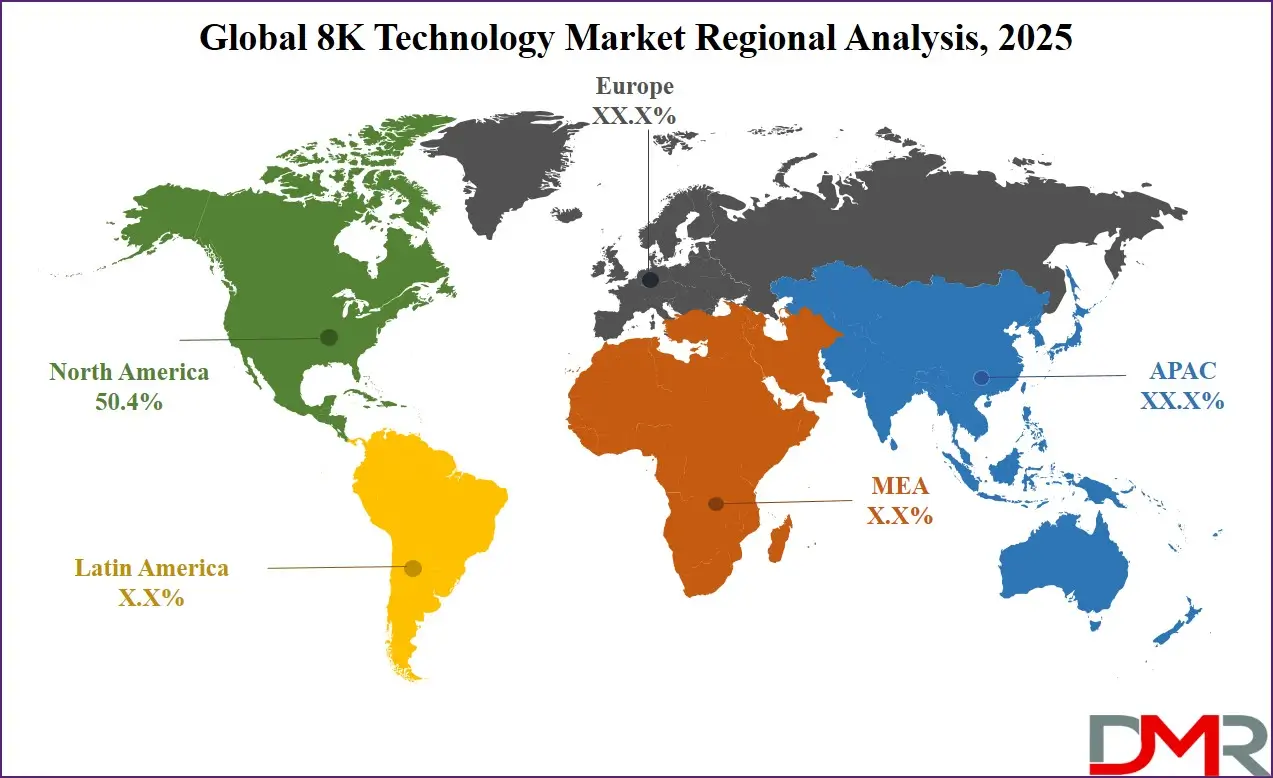
The presence of a mature entertainment industry and advanced broadcasting networks supports the shift toward ultra-high-definition formats. It is also estimated that rising interest in immersive home viewing experiences, especially through sports and cinema content, is helping fuel this growth. Furthermore, ongoing development in streaming platforms and high-speed internet infrastructure in the US and Canada adds to the region’s strength, making North America a key force in shaping the global 8K technology market.
Fastest Growing Region in the 8K Technology Market
Asia Pacific is showing significant growth over the forecast period in the 8K technology market, supported by rapid advancements in display manufacturing, rising consumer demand, and increasing investments in smart home electronics. Countries like Japan, China, and South Korea are leading the way in producing 8K televisions, high-resolution cameras, and advanced semiconductor components. The region benefits from strong local production, government support for innovation, and a tech-savvy population eager to adopt the latest visual technologies. It is estimated that expanding digital infrastructure and the growing popularity of ultra-high-definition entertainment will further boost demand. Asia Pacific is also becoming a major hub for 8K content creation, helping drive global market expansion.
By Region
North America
Europe
- Germany
- The U.K.
- France
- Italy
- Russia
- Spain
- Benelux
- Nordic
- Rest of Europe
Asia-Pacific
- China
- Japan
- South Korea
- India
- ANZ
- ASEAN
- Rest of Asia-Pacific
Latin America
- Brazil
- Mexico
- Argentina
- Colombia
- Rest of Latin America
Middle East & Africa
- Saudi Arabia
- UAE
- South Africa
- Israel
- Egypt
- Rest of MEA
Competitive Landscape
The 8K technology market is becoming highly competitive as more companies try to lead in advanced display and content creation. The competition mainly focuses on producing high-quality 8K televisions, cameras, and monitors, as well as developing software that supports smooth streaming and upscaling of lower-resolution content. Companies are also racing to improve energy efficiency, reduce costs, and create user-friendly features. Partnerships between hardware makers, streaming services, and content creators are growing to fill the gap in native 8K content. Some firms are focusing on professional uses like filmmaking, medical imaging, and advertising, where 8K can offer a real advantage. This competitive push is helping to slowly build a foundation for wider use and adoption of 8K technology in the future.
Some of the prominent players in the global 8K Technology are:
- Samsung Electronics
- LG Electronics
- Sony Corporation
- Panasonic Corporation
- Canon Inc.
- Sharp Corporation
- BOE Technology Group
- Hisense Co. Ltd.
- Dell Technologies
- Red Digital Cinema
- Digital Projection
- Ikegami Tsushinki
- AUO Corporation
- JVCKENWOOD Corporation
- Pimax
- TCL Corporation
- Skyworth
- Changhong Electric
- NanoLumens
- Apple
- Other Key Players
Recent Developments
- In May 2025, Samsung formally announced that its Vision AI would be shipping out with its updated Neo QLED 8K TV lineup. But the lineup’s greatest selling point is perhaps the fact that Samsung is going completely, if not nearly, wireless with the lineup. The Neo QLED 8K TV will not ship out with a new box that wirelessly connects other devices to the TV. The technology is known as Wireless One Connect and rather than have the box sitting close to the TV, Samsung boasts that you can put the proprietary box anywhere in the room, and it will still be able to project and stream video content directly to the TV, and at a maximum resolution of 8K 120Hz.
- In April 2025, Kaleidescape, joined the 8K Association (8KA) to support the advancement and standardization of 8K technology. This move reflects its commitment to innovation in premium home entertainment. Kaleidescape stands out as the only digital movie provider offering lossless audio and full reference video quality. Its high-bitrate movie downloads, stored locally without file size limits, ensure flawless playback. This unmatched quality, far beyond that of Blu-ray, delivers the most immersive and high-fidelity viewing experience available at home.
- In January 2025, Pimax has unveiled the Dream Air, the world’s smallest full-feature 8K resolution VR headset. Introduced during an online keynote, the lightweight device features 27 million pixels, head, hand, and eye-tracking, integrated spatial audio, a DisplayPort connection, and a self-adjusting backstrap. Designed as a PCVR headset, it incorporates micro-OLED panels and pancake lenses from the Crystal Super but in a compact form. Marking a shift in design, the Dream Air represents Pimax’s move into a new era focused on small form factor VR headsets for broader use cases.
- In March 2024, Skyworth Digital launched the first commercial 8K set-top box (STB) in collaboration with China Mobile. This groundbreaking product represents the telecom market’s first commercial 8K TV service, with an impressive rollout of 40,000 units in China’s He Nan province in 2024. The launch marks a major milestone in ultra-high-definition broadcasting. Additionally, China Mobile and Skyworth plan to extend the reach of this 8K device to more provinces, continuing to drive innovation in the market.
Report Details
| Report Characteristics |
| Market Size (2025) |
USD 42.7 Bn |
| Forecast Value (2034) |
USD 2,296.2 Bn |
| CAGR (2025–2034) |
55.7% |
| Historical Data |
2019 – 2024 |
| The US Market Size (2025) |
USD 18.0 Bn |
| Forecast Data |
2025 – 2033 |
| Base Year |
2024 |
| Estimate Year |
2025 |
| Report Coverage |
Market Revenue Estimation, Market Dynamics, Competitive Landscape, Growth Factors, etc. |
| Segments Covered |
By Product (TV, Monitor & Notebook, Professional Camera, Projector, and Others), By End User (Sports & Entertainment, Medical, Consumer Electronics, and Others) |
| Regional Coverage |
North America – US, Canada; Europe – Germany, UK, France, Russia, Spain, Italy, Benelux, Nordic, Rest of Europe; Asia-Pacific – China, Japan, South Korea, India, ANZ, ASEAN, Rest of APAC; Latin America – Brazil, Mexico, Argentina, Colombia, Rest of Latin America; Middle East & Africa – Saudi Arabia, UAE, South Africa, Turkey, Egypt, Israel, Rest of MEA |
| Prominent Players |
Samsung Electronics, LG Electronics, Sony Corporation, Panasonic Corporation, Canon Inc., Sharp Corporation, BOE Technology Group, Hisense Co. Ltd., Dell Technologies, Red Digital Cinema, Digital Projection, Ikegami Tsushinki, AUO Corporation, JVCKENWOOD Corporation, Pimax, TCL Corporation, Skyworth, Changhong Electric, NanoLumens, Apple, and Other Key Players |
| Purchase Options |
We have three licenses to opt for: Single User License (Limited to 1 user), Multi-User License (Up to 5 Users), and Corporate Use License (Unlimited User) along with free report customization equivalent to 0 analyst working days, 3 analysts working days, and 5 analysts working days respectively. |
Frequently Asked Questions
The Global 8K Technology Market size is expected to reach a value of USD 42.7 billion in 2025 and is expected to reach USD 2,296.2 billion by the end of 2034.
North America is expected to have the largest market share in the Global 8K Technology Market, with a share of about 50.4% in 2025.
Some of the major key players in the Global 8K Technology Market are Samsung Electronics, LG Electronics, Sony Corporation, and others
The market is growing at a CAGR of 53.9 percent over the forecasted period.